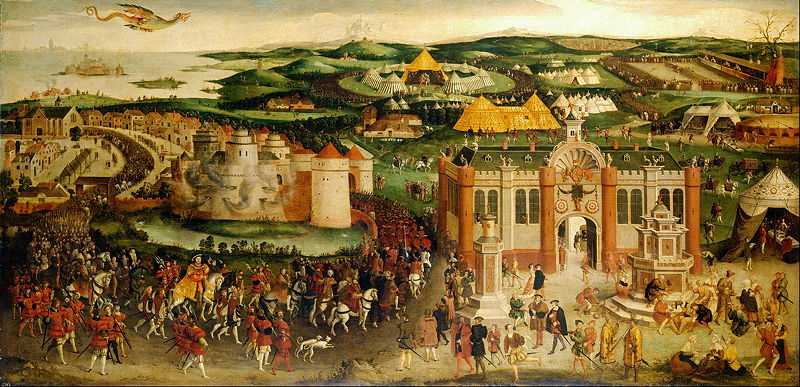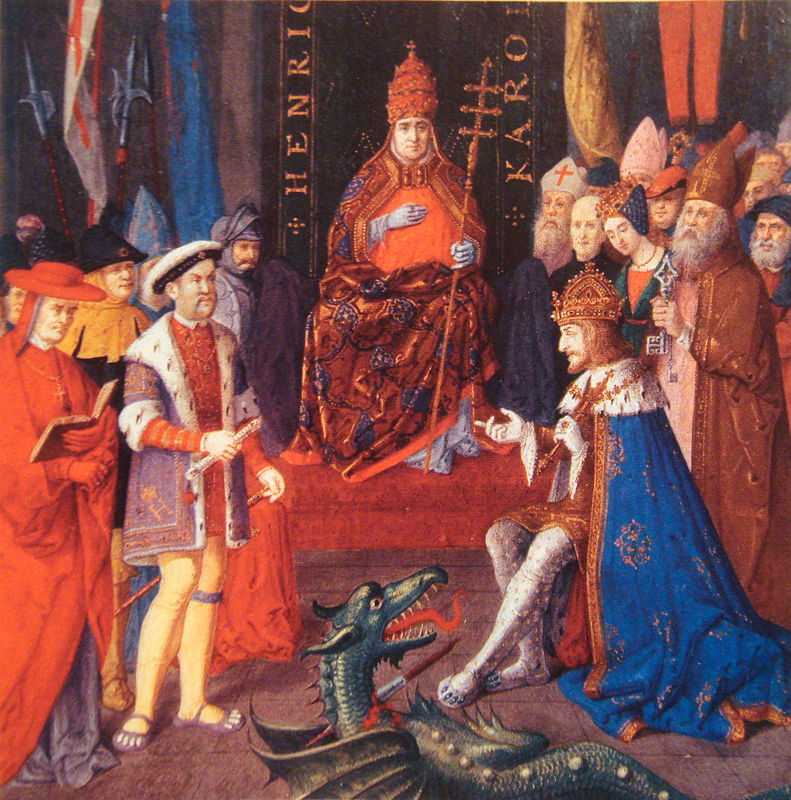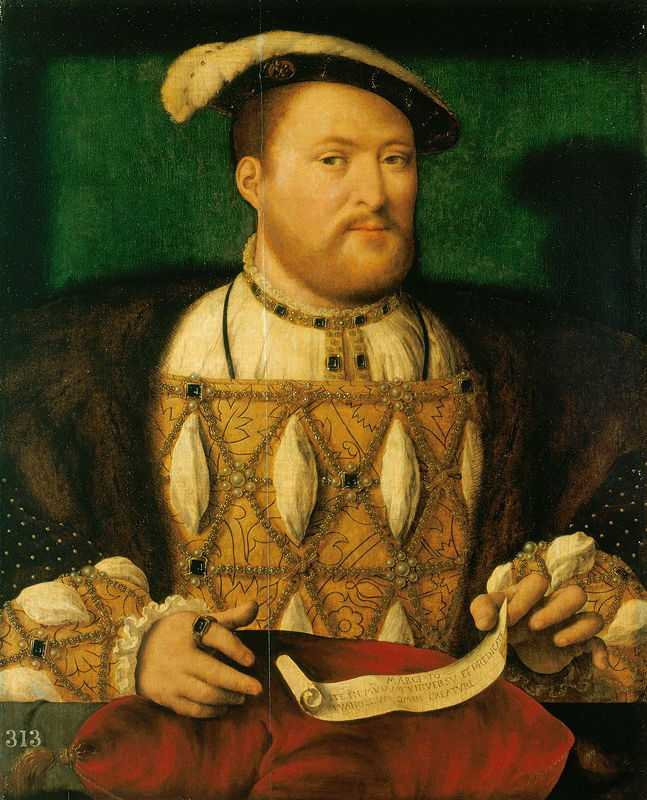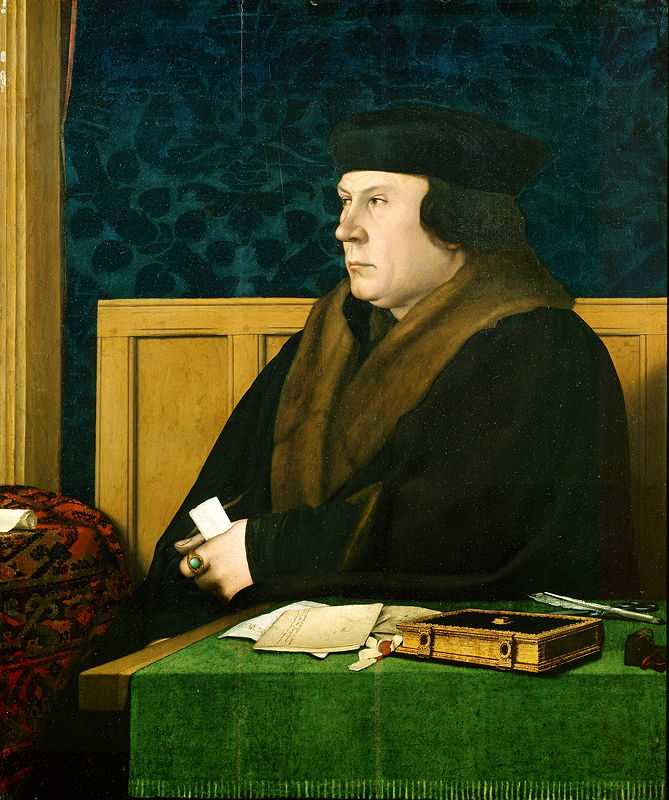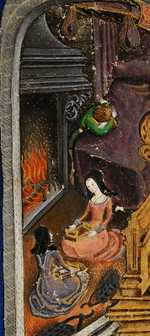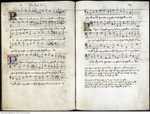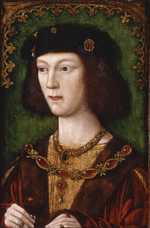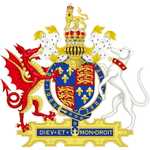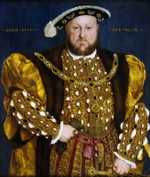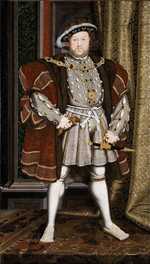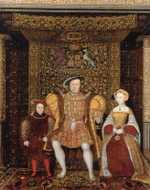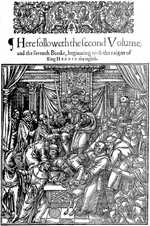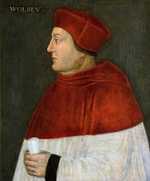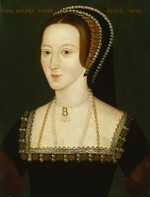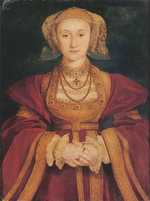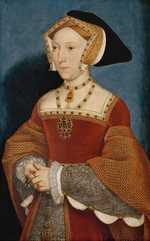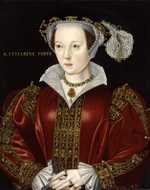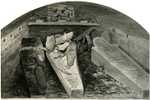1. Henry VIII’s Early Years
Henry Tudor was born on 28 June 1491 in Greenwich, Kent, at the Palace of Placentia. Tudor was the third child of Henry VII and Elizabeth of York. Only three of Tudor's siblings survived infancy.
Early childhood
Henry was baptised at the church of the Order of the Franciscan Observants by the Bishop of Exeter and Lord Privy Seal, Richard Fox.
Since his infancy, he had many carers tending to him. Mistress Anne Oxenburg was his wet nurse. His paternal grandmother Lady Margaret Beaufort, insisted that all Oxenburg’s meals had to be approved by a physician.
Oxford was assisted by two “rockers” who rocked his cradle, Frideswide Puttenham and Margaret Draughton.
Henry and his siblings moved with their mother from castle to castle, depending on the season and her royal duties. Henry’s older brother Arthur, who was heir to the throne, was raised separately according to royal tradition.
Young Henry spent his early childhood as the only male in his immediate environment. His playmates were his sisters, he had a host of female carers and his grandmother Margaret doted on him.
When he became king almost two decades later, Henry remembered the women who took care of him in his childhood, and he ensured that they were taken care of financially in their old age.
Henry was schooled by prominent tutors, such as John Skelton. The young royal was taught Italian, Latin and French.
Early styles and titles
As a young child, starting at the age of two, Henry got awarded a string of titles. The reason for this was that his father wanted to maintain control of prominent positions.
This was also sparked by a man called Perkin Warbeck claiming to be Richard Shrewsbury, Duke of York, who was a long-lost pretender to the English throne. About a decade after Warbeck’s initial claims, he was hanged.
The young Henry ’s styles and titles were symbolic, and the duties and responsibilities that came with them were performed by other officials. He had to continuously attend a host of ceremonies in his early childhood though.
On 5 April 1493, at the age of two, Henry was made Lord Warden of the fourteen Cinque Ports on the south-east coast of England and the Constable of Dover Castle.
Shortly thereafter he was appointed Earl Marshal of England and Lord Deputy of Ireland on 12 September 1494.
At the age of three he was made the Duke of York and a knight of the Most Honourable Order of the Bath.
In addition, he was made Warden of the Scottish Marches and appointed to the Order of the Garter.
Heir to the Throne
At the age of ten, Henry lost another sibling to death. His elder brother Arthur, the heir apparent, died of an unknown illness at the age of 16.
The young Henry—who then became the next in line to the throne—had to take on his deceased brother's responsibilities; and he got appointed the Duke of Cornwall, the Earl of Chester and the Prince of Wales.
Henry's brother Arthur had been married for six months when he died, leaving his wife Catherine of Aragon—from the royal house of Spain—widowed at a young age.
Henry VII did not want to lose England's marital alliance with Spain, so Catherine—who said that her marriage to Arthur had not been consummated— was betrothed to the eleven-year-old Henry with the blessing of her mother.
Henry and Catherine were to get married when he turned 15. When he reached this age though; Catherine’s father, King Ferdinand II of Spain, still owed half of her wedding portion. Because of this, the wedding did not take place.
In addition, the young Henry submitted a protest to Bishop Fox, disowning the marriage contract he had entered at an earlier age, stating that he would at no stage validate or ratify it. The young prince never opposed his father, so it is believed that Henry VII was behind this.
At the time, Tudor’s father started thinking of marrying Tudor to Eleanor, the daughter of Philip of Habsburg, the Duke of Burgundy. Eleanor was closer to the prince’s age.
Marguerite de Navarre, a French princess, was another possible bride for Henry.
Catherine's father wanted her to stay on in England due to political instability in her home country. He appointed her as the Spanish ambassador to England, which enabled her to stay in England indefinitely.
2. Henry VIII Becomes King
Henry succeeded his father as king at the age of 17 when Henry VII died of tuberculosis in April 1509.
The King gets married
Shortly after his father's death Henry decided to go ahead and marry Catherine, stating it had been Henry VII's dying wish.
The marriage between Henry and Catherine was solemnized on 11 June 1509 in the Franciscan church in Greenwich.
In June 1509 Henry and Catherine were crowned the King and Queen of England by the archbishop of Canterbury. Afterwards, a lavish banquet was held at Westminster Hall, followed by days of festivities.
France
Immediately after he became King, he publicly vowed to attack the King of France, Louis XII.
Despite criticism from various quarters; Henry rekindled the Hundred Years War, which was a series of conflicts between England and France. He also soured relations with Scotland.
Henry couldn’t go ahead with attacking France though, as he didn’t have the support of the council his father had chosen for him. In addition, he battled to get external allies to join him in attacking France.
He then wrote to his father-in-law, asking him to be his ally.
His father-in-law advised him to pretend to be at peace with France, and to rather attack them at a later, more opportune stage. Henry wrote to France to make amends, but they didn’t respond warmly to his efforts.
After some of Henry’s councillors intensely pleaded with him, an Anglo-French treaty was signed in March 1510. In May 1510 England signed a treaty with Spain, which almost entirely annulled the recent agreement with France.
Some time later, Henry tried to persuade his council to declare war on France, but his efforts were fruitless.
Henry’s desire to attack France finally materialised when relations between Louis and Pope Julius II soured. Henry now had a good reason to attack France, plus an abundance of allies.
3. Henry VIII’s Military Exploits and Early Years as King
Henry’s ambition was to engage in military exploits, whereas his father had been focussed on making money and enforcing laws.
Because the new King was not that focussed on economic development, the treasure handed down from his father was swiftly eroded during his reign.
Gelders and North Africa
Around this time, Henry sent archers to launch a small-scale attack on the Duke of Gelders, whose territory was located in the present-day Germany. He did this to impress his ally Maximilian I, the Holy Roman Emperor.
This turned out to be a successful military exploit.
In May 1511 he sent Lord Darcy with 1,000 men to support Ferdinand against the Moors in North Africa, which turned out to be an unsuccessful military venture.
France again
When Henry’s were ready to proceed with attacking France, he dispatched a naval fleet with 6,000 men as well as 12,000 foot soldiers.
This turned out to be a disaster. When the troops arrived at Aquitaine; where they were planning to launch a joint attack with Spain on France, they discovered that their ally was ill-prepared.
Ferdinand’s commanders disagreed with Henry’s on where to launch the attack from. It became clear that Henry’s father-in-law had tricked him, intending to redirect the English troops to attack Navarre, a territory he was planning to conquer.
Ferdinand’s men went ahead and conquered Navarre without the English troops. By the time a letter from Henry arrived giving them permission to join Spain in the attack against Navarre, his troops had set sail for home already.
Henry’s father-in-law blamed the fiasco on the English soldiers.
This defeat did not damage Henry’s military ambitions. In early 1513 he put military pressure on Maximillian, and persuaded him to support the Anglo-Spanish alliance.
In mid-March 1513 Henry’s army launched another attack on France, but it was unsuccessful. Shortly thereafter another attack was launched on France. Henry, supported by a massive personal entourage, joined the troops.
This time around they achieved victory. The English forces wiped out the diocese of Thérouanne, except for the church. They conquered the citadel of Tournai, but they decided to annex it instead of annihilating it as they did with Thérouanne.
Scottish attack
In Henry’s absence, his Scottish enemy King James IV seized the opportunity and crossed the River Tweed to attack England. This was a bad decision. The Scottish forces suffered defeat, and James himself was killed.
After a few years of deliberations and political changes in Europe, England and France signed a peace treaty, the Treaty of the More, on 30 August 1525.
France and Scotland again
Many years later, Henry started planning an invasion of France once again. To prepare for this, Henry tried to remove the potential threat of Scotland under James V.
The Scots were defeated on 24 November 1542, and James died in mid-December.
Henry then tried to unite the crowns of England and Scotland by arranging a marriage between his son and James' successor, Queen Mary. This was rejected by the Parliament of Scotland on 11 December.
Eight years of war between England and Scotland ensued, which was called "the Rough Wooing”.
Henry attacked France in 1544. The English lay siege to Boulogne, and it fell on 18 September 1544.
On 7 June 1546, France and England signed the Treaty of Camp. Henry was to return Boulogne to France after eight years for 2 millions crowns.
Catherine of Aragon’s pregnancies
Henry and Catherine's first child, a daughter, was stillborn on 31 January 1510.
On New Years Day 1511 Catherine gave birth to Henry's son, Henry Prince of Wales. The event was followed by many days of celebration, but the baby died at the age of seven weeks.
Following this Catherine gave birth to two sons, but both were stillborn. In 1516 she gave birth to a daughter, Mary, which improved the couple's relationship.
In 1518 Catherine gave birth to another daughter, but she was stillborn.
Tudor’s early mistresses
The Tudors’ marriage was described as unusually good. Even so, Henry had his first extramarital affair in 1510, the year after he married Catherine.
His first known mistress was one of the 3rd Duke of Buckingham’s sisters, but it is not clear which one.
Elizabeth “Bessie” Blount, one of Henry’s mistresses, gave birth to his son, Henry FitzRoy, on 15 June 1519. FitzRoy was made the Duke of Richmond and Somerset, and Earl of Nottingham.
The birth and survival of FitzRoy was seen as evidence that the King could produce healthy male offspring.
FitzRoy’s died in 1536. At the time, Parliament was in the process of passing the Second Succession Act, which could have made it possible for him to become King.
Henry also had an affair with Mary Boleyn, Catherine's lady-in-waiting. Some historians believe that he was the father of Mary’s two children, Henry and Catherine Carey, but this was never proven.
Around the time, Tudor also became attracted to Boleyn's sister, Anne.
Attempts to oust Catherine
Henry needed a legitimate male heir before his death. Around 1525, as he was approaching his mid-30s and Catherine entered her 40s, he started weighing up his options: arrange for his daughter Mary to get married in the hope that she would bear him a grandson, legitimize his son FitzRoy or marry someone else.
Legitimising Fitzroy would involve the intervention of the Pope, and it was doubtful that this would succeed. Hoping for the young Mary—who was only around nine years old at the time—to give him a grandson, was not a viable option.
This left only one option: finding another wife. So Catherine had to go.
4. Henry VIII Versus the Catholic Church
Around 1527 Henry started believing that the biblical scripture of Leviticus 20:21 held the answer to the reason that he didn’t have a legitimate male heir. This verse states that if a man marries his brother’s wife, they will be cursed with childlessness.
Henry pleads his case with the Pope
Henry believed that the Pope was not allowed to scrap this biblical law, which in his mind made his marriage to Catherine unlawful.
Up to this point Henry had been a staunch supporter of the supreme power of the Pope. He had demonstrated this with his military support; and he published Defence of the Seven Sacraments in 1521, in which he attacked early Protestant reforms.
Pope Leo X awarded Henry the title Defender of the Faith for writing Defence of the Seven Sacraments.
In 1527 Henry argued the scripture in Leviticus with Pope Clement VII, but this was unsuccessful. Following this, more efforts to plead his case were unsuccessful as well.
Henry turns on the church
Henry blamed Cardinal Wolsey, the English Archbishop, for this. In 1929 Wolsey was charged with asserting foreign jurisdiction, including papal jurisdiction, against the King's supremacy. Henry officially pardoned Wolsey a few months later, but shortly thereafter he was charged with treason.
Wolsey died of natural causes while he was awaiting trial.
Henry increasingly focussed on changing laws to assert the power of the monarchy over the church, assisted by Thomas Cranmer, Thomas Cromwell, Thomas Audley and the Duke of Norfolk.
When these legal changes were completed, Sir Thomas More resigned as Lord High Chancellor in May 1532, and he was succeeded by Cromwell.
Catherine of Aragon ousted
In the early 1530s Catherine was ousted from the royal court, and her quarters were given to Anne Boleyn.
She was also separated from her daughter, and until her death in 1536 she had to live in several cold and damp castles and manors. She hardly ever complained, and spent a lot of time praying.
Marriage to Anne Boleyn
Henry married Anne Boleyn in secret, even though he was still legally married to Catherine.
Anne became pregnant, and the couple got married in public on 25 January 1533.
On 23 May 1533 Cranmer annulled Tudor's marriage to Catherine at a special court at Dunstable Priory. Catherine lost her title, and she got the title back that she had when she was Arthur Tudor's widow, which was Princess Dowager of Wales.
Five days later Cranmer validated the marriage of Henry and Boleyn, and she became queen consort on 1 June 1533.
On 7 September 1533 Anne gave birth to a daughter, whom they named Elizabeth.
The Act of Succession was promulgated in 1533. As a result, Catherine's daughter Mary was declared illegitimate, and Anne’s daughter Elizabeth was chosen as the next in line to the throne.
Excommunication
Pope Clement excommunicated Henry and Cranmer from the Catholic Church as a result of the royal wedding.
More laws were passed that didn’t sit well with the Pope. The Act in Restraint of Appeals in 1532 voided the right to appeal to Rome, and the Act of Supremacy that was passed in 1534, made the King the head of the church in England.
Pope Paul III excommunicated Cromwell because he destroyed the shrine of St Thomas Beckett at Canterbury.
Religious unrest
Henry's government dealt swiftly with resistance to the new laws, and many monks were pilloried or executed.
The Bishop of Rochester, John Fisher, refused to accept Henry as the Supreme Head of the Church of England. The Pope tried to save Fisher’s life by offering him another position.
Henry laughed this off, saying Fisher would have to wear his new Cardinal’s hat on his shoulders, implying that he would soon have no head.
Fisher was beheaded on 22 June 1535. Sir Thomas More, the previous Lord High Chancellor, was beheaded for the same reason.
This was followed by more resistance to Henry's reforms in the north of England in 1536, with between 20,000 and 40,000 rebels opposing the changes.
Henry expressed gratitude to the rebels for highlighting their issues, but when more violence broke out, he arrested around 200 rebels and had them executed.
This ended opposition to his reforms.
In 1540 he gave the go-ahead to eradicate saints’ shrines. The last of the monasteries in England were dissolved in 1542, and the Crown took possession of their property.
Only archbishops and bishops remained in the House of Lords, abbots and priors lost their seats. For the first time in history the Lords Temporal outnumbered the Lords Spiritual in the House of Lords.
5. Death of Anne Boleyn and Henry VIII’s Other Failed Marriages
Anne’s temperament was not fitting for a queen. She was on occasion witnessed speaking to her uncle “in words that shouldn't be used to a dog”.
Execution of Anne Boleyn
She had a miscarriage or stillbirth in 1934. In Christmas 1534 Henry was discussing with Cranmer and Cromwell how to divorce her without having to be reconciled to Catherine.
In January 1536, when Anne was pregnant again, Henry fell off a horse during a tournament and got badly hurt. Initially it seemed as if he had been critically injured. Due to shock when she received the news, Anne—who was three-and -a-half months pregnant — miscarried the King's son.
Catherine of Aragon had died earlier that month, and Anne miscarried on the day of her predecessor's funeral.
This miscarriage, together with political opposition against her from different quarters, signalled the beginning of the end for her.
The writing on the wall was when Henry's new mistress, Anne's lady-in-waiting Jane Seymour, was moved into new quarters. Another omen was when Anne's brother, George, was refused the Order of the Garter.
In early May Anne, George and four other men were arrested. The men, including George, were accused of having sexual relationships with her and charged with treason and adultery. Despite poor evidence against them, they were all found guilty.
The men were executed on 17 May 1536, and Anne, who seemed very happy and ready to die, was beheaded two days later. Henry didn’t want her to be beheaded with the common axe, so he dispatched an expert swordsman from France to perform the duty.
Jane Seymour
Henry got engaged to Jane the day after Boleyn's execution, and the couple got married ten days later.
On 12 October 1537, Henry at last got his long-awaited male heir when Jane gave birth to the king's son, Edward.
Twelve days later Jane died due to complications during childbirth.
Anne of Cleves
A search for a new wife for Henry started immediately, and Cromwell and the court turned their attention to other European countries.
Cromwell suggested that Henry marry the Duke of Cleves's sister,Anne. Cleves was a historical area located across modern-day Germany and Holland.
Germain painter Hans Holbein the Younger painted a portrait of Anne. This picture, together with complimentary descriptions of Anne by his courtiers, convinced Henry to marry Anne.
Henry was disturbed by Anne’s plain appearance when he met her though. He blamed Cromwell for the painting that he felt was inaccurate, and for exaggerated reports of Anne’s beauty.
Despite Henry’s misgivings, he married Anne on 6 January 1540, but the marriage was never consummated.
Anne agreed to the annulment, and she confirmed that the marriage had never been consummated. She was awarded a generous settlement, including a palace and a castle, and she remained on very good terms with Henry.
Anne was known as “The King's Beloved Sister" moving forward.
Cromwell’s demise
At this time, the tide started turning on Cromwell.
His allies at the court; religious reformers Robert Barnes, William Jerome, and Thomas Garret; were burned for being heretics.
He was charged with a range of fraudulent activities, such as selling export licences and granting passports, and treason. One of the reasons for the treason charges was the inaccurate painting and description of Anne of Cleves.
He was found guilty and beheaded on 28 July 1540.
Catherine Howard
Henry then set his sights on Catherine Howard, the daughter of a political opponent, the Duke of Norfolk. Before his death, Cromwell had expressed concern about Henry’s interest in Catherine.
On the day that Cromwell was beheaded, Henry married Catherine. He was completely taken with her and gave her Cromwell's lands and showered her with jewellery.
Soon after the wedding, in the spring of 1541 Catherin had an affair with her distant cousin Thomas Culpeper.
After rumours started surfacing, Cranmer started investigating. It then also came to light that Catherine had had a physical relationship with Francis Dereham prior to meeting Henry. Dereham was her secretary at the time of the relationship.
Culpeper and Dereham were both found guilty of high treason and executed on 10 December 1541. Catherine was jailed for a few months, and beheaded on 10 February 1542.
Many members of Catherine’s family were found guilty of concealing treason, and sentenced to life imprisonment and forfeiture of goods.
Henry became depressed, and started to indulge more in food an in women.
6. Henry VIII’s Last Years
The widow Catherine Parr was the last of Henry’s six wives. He got married to her on 12 July 1543.
Catherine Parr
Catherine had four husbands in total—three before Henry, making her the most-married English queen.
She influenced Henry to pass the Third Succession Act in 1543, which restored the King’s two daughters as successors to the throne.
She died one year after Henry due to complications during childbirth.
Henry’s Death
In his final years, Henry was very overweight, and he had to be moved around with mechanical inventions. An old leg wound of his became infected, and he suffered from aching boils. He was also extremely moody.
Henry died at the age of 55 on 28 January 1547 at the Palace of Whitehall. He was placed in a vault at St George’s Chapel at Windsor Castle next to Jane Seymour.
